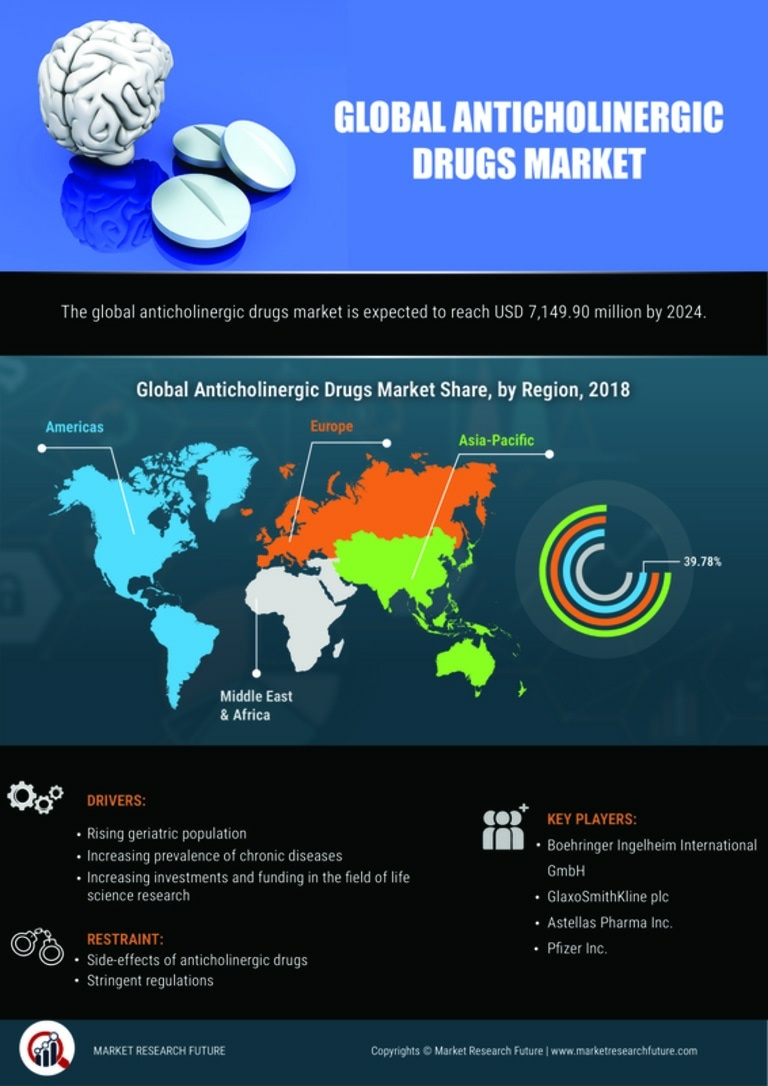Growing Geriatric Population
The Anticholinergic Drugs Market is significantly influenced by the growing geriatric population, which is more susceptible to chronic diseases requiring pharmacological intervention. As individuals age, the incidence of conditions such as incontinence and respiratory issues increases, leading to a higher demand for anticholinergic medications. Data suggests that the elderly population is projected to reach unprecedented levels, thereby amplifying the need for effective treatment options. This demographic shift is likely to drive the Anticholinergic Drugs Market, as healthcare systems adapt to cater to the unique needs of older patients. The focus on improving the quality of life for this population segment further emphasizes the relevance of anticholinergic drugs in contemporary healthcare.
Innovations in Drug Formulations
The Anticholinergic Drugs Market is benefiting from innovations in drug formulations that enhance the efficacy and safety profiles of anticholinergic medications. Recent advancements in pharmaceutical technology have led to the development of extended-release formulations and combination therapies, which improve patient adherence and therapeutic outcomes. Market data indicates that these innovations are attracting attention from both healthcare providers and patients, as they offer more convenient and effective treatment options. The ongoing research and development efforts in this area suggest a promising future for the Anticholinergic Drugs Market, as new formulations are likely to expand the therapeutic applications and improve the overall patient experience.
Increased Awareness and Education
The Anticholinergic Drugs Market is experiencing growth due to increased awareness and education regarding the benefits and risks associated with anticholinergic medications. Healthcare professionals and patients are becoming more informed about the therapeutic potential of these drugs, particularly in managing chronic conditions. Educational initiatives and outreach programs are playing a crucial role in disseminating information, which is likely to lead to higher prescription rates. Market data reflects a positive correlation between awareness campaigns and the uptake of anticholinergic therapies. This trend indicates that as knowledge about these medications spreads, the Anticholinergic Drugs Market may continue to expand, driven by informed decision-making among healthcare providers and patients alike.
Rising Prevalence of Respiratory Disorders
The Anticholinergic Drugs Market is experiencing a notable surge due to the increasing prevalence of respiratory disorders such as chronic obstructive pulmonary disease (COPD) and asthma. According to recent data, the incidence of these conditions is projected to rise, leading to a higher demand for effective treatment options. Anticholinergic drugs, known for their bronchodilator properties, are becoming essential in managing these diseases. The market for anticholinergic medications is expected to expand as healthcare providers increasingly recognize their efficacy in alleviating symptoms and improving patients' quality of life. This trend suggests a robust growth trajectory for the Anticholinergic Drugs Market, driven by the urgent need for innovative therapies to address the growing burden of respiratory ailments.
Expanding Applications in Neurological Disorders
The Anticholinergic Drugs Market is witnessing growth due to the expanding applications of these medications in treating neurological disorders. Conditions such as Parkinson's disease and overactive bladder are increasingly being managed with anticholinergic agents, which help alleviate symptoms by blocking acetylcholine receptors. The market data indicates a rising adoption of these drugs in neurology, as they offer significant benefits in symptom management. As the understanding of these disorders evolves, the potential for anticholinergic drugs to play a pivotal role in treatment regimens becomes more apparent. This expansion into new therapeutic areas is likely to bolster the Anticholinergic Drugs Market, reflecting a shift towards more comprehensive treatment strategies.


















Leave a Comment